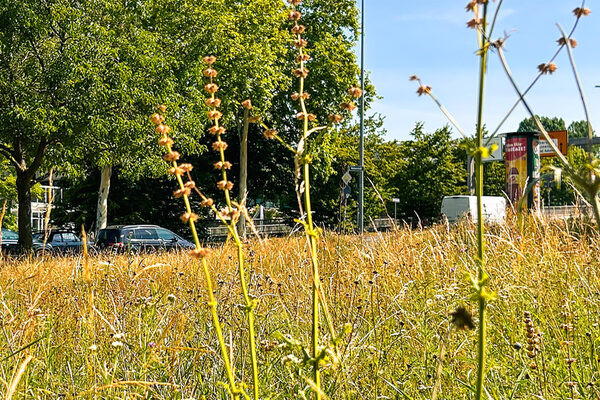Naturally Wiesbaden - Wild meadows in the city
Wild meadows are not a temporary solution - they are habitats with a future!
New meadows for more biodiversity, climate and water protection
New, near-natural meadow areas are currently being created in Wiesbaden. They are replacing lawns that were previously regularly and intensively maintained. Thanks to more restrained maintenance, grasses, wild flowers and herbs are now allowed to grow here - mainly native species that are adapted to the location and serve as a habitat for many animals. This creates valuable habitats for insects, birds and other animals - right in the heart of the city.
With this project, the Parks Department is implementing targeted measures for more biodiversity, a better urban climate and the principle of the "sponge city": Wiesbaden is thus becoming more sustainable and greener.
Valuable Wild Wiesbaden
"Wild meadows" are near-natural green spaces that are deliberately maintained less intensively. Instead of short-cut lawns, native wild flowers, herbs and grasses grow here. These areas deliberately look a little wilder - but they are not unkempt, they follow a clear ecological concept.
More biodiversity
Wild meadows provide food, shelter and habitat for many animals, such as wild bees, butterflies, beetles and birds.
Better urban climate
Near-natural meadow areas help to noticeably cool the city in summer. They release more moisture through evaporation and thus act as a climate buffer between streets, buildings and sidewalks.
Natural water reservoir - for the sponge city of Wiesbaden
Near-natural meadows are better at absorbing rainwater and storing it in the soil than sealed surfaces or traditional lawns.
Lawn or meadow - what makes the difference?
Many areas in the city are traditionally laid out as lawns: short mowed, uniformly green and easy to maintain. But from an ecological point of view, such areas offer little habitat and hardly any diversity. The new meadow areas, on the other hand, are developing into species-rich, vibrant habitats. They bring more color to the cityscape - and at the same time make an important contribution to environmental and climate protection.
And what about usage?
Wild meadows are not lawns or play areas - they need time and peace and quiet to develop. Many areas are therefore not intended to be walked on. Where possible, however, care is taken to ensure a balanced design:
- with pathways along or through the meadows
- information boards to explain the areas
- or pruning at the edges to maintain clarity and safety.
This allows you to observe, experience and appreciate nature without disturbing it.
So you too can make a contribution
- Plant native flowers in the garden or on the balcony
- Simply let small corners grow Design garden areas close to nature - without fertilizers or pesticides
- Offer insects shelter - for example with an insect hotel
Documents
Contact us
Parks department
Address
65189 Wiesbaden
Postal address
65029 Wiesbaden
Arrival
Notes on public transport
Bus stop Statistisches Bundesamt; bus lines 16, 22, 27, 28, 37, 45, X26, x72, 262
Telephone
- +49 611 312901Office management
- +49 611 312905Parks and green spaces, children's playgrounds, public trees
- +49 611 23608513Urban forest, agriculture
- +49 611 23608518Terra Levis burial forest
- +49 611 313241Cemeteries in Wiesbaden
- +49 611 4090770Pheasantry
Opening hours
Mondays to Fridays from 8 a.m. to 12 noon, afternoons by appointment.
Information on accessibility
- Barrier-free access is available
- The WC is barrier-free
